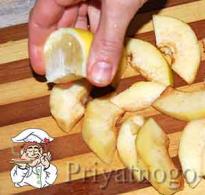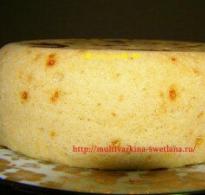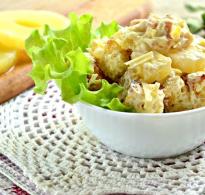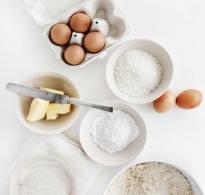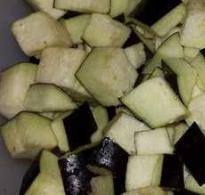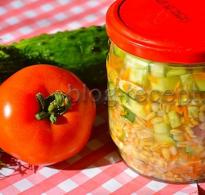How to pair cheese with wine correctly. Which wine to pair with cheese, or the most harmonious duet in gastronomy
Food ecology: Cheese and wine are a classic union. But making a successful wine and cheese pairing is not as easy as it might seem at first glance
Cheese and wine are a classic pairing. But making a successful wine and cheese pairing is not as easy as it might seem at first glance. How to figure it out huge variety and find perfect combination that will give you true pleasure?
Today before us various types cheeses, ready to serve with a glass of wine. We suggest you try it modern options their combinations.
Full-bodied red wine with cheese
Full-bodied red wines like cabernet sauvignon, shiraz and zinfandel pair perfectly with cheeses of similar intensity. Choose firm, salty cheeses that are best served with lightly grilled bread.
Creating the perfect combination
Each wine is unique. The wine you selected is too dry and spicy taste? Less hard cheeses will help soften the bitterness of tannins and reduce acidity. So, for example, it is best to serve luxurious Barolo cheese with a 5-month aged sconce duro.
Cheese options that pair well with rich red wines:
- aged gouda;
- extra cloth-aged cheddar;
- cheddar from goat milk;
- smoked cheddar or gouda;
- Basque sheep's milk cheese;
- gran padano;
- fiore sardo;
- pecorino;
- Manchego.
Light red wine with cheese
Light red wines such as pinot noir or beaujolais pair well with flavored cheeses such as taleggio and semi hard cheeses with nutty undertones and a Gruyère-like taste. If you prefer more soft cheeses, then try pairing light red wines with mature brie or camembert cheeses.
Cheese options for pairing with light red wines:
- conte extra;
- swiss cheese;
- kakle;
- provolone;
- caciocavallo;
- Saint-Necteux;
- Pont-l'eve;
- osso-irati;
- nocerino;
- fontina;
- brie;
- Camembert;
- coulomier;
- rasker;
- taleggio.
White wine and cheese
White wines traditionally pair well with more cheeses than reds. This is because white wines lack tannins, making them easier to pair. The only type of cheese that does not go well with white wines is blue cheese. In most cases, it sounds brighter than the wine and overpowers its taste. There will be no such problems with other cheeses.
In the Loire Valley, where Sauvignon Blanc originates, you can see numerous herds of goats. French goat cheeses are quite dense and have a chalky texture due to their high calcium content. As these cheeses age, they acquire a sharpness that makes them a fantastic pairing with Sauvignon Blanc and Chardonnay. Consider Crotin de Chavignol or Hambolt Fog as ideal companions for white wine.
In the province of Veneto there are vineyards dominated by the Garganega grape variety, from which Soave wines are made. This wine has the same fresh taste, like Sauvignon Blanc, and in the aftertaste bitter notes of almond are clearly audible. It is these shades that make this wine a surprisingly good match for young Asiago. But aged Asiago goes well with fruity semi-dry prosecco or moscato d’asti.
Semi-dry types of Riesling (German Riesling from the Moselle, for example) go well with fondue. Sweetness and acidity harmonize well with the nutty, rich taste of the fondue and give the taste exquisitely sweet and slightly salty shades.
The best examples of Chardonnay are created in cool climates, where the grapes have complex floral and fruity aromas, and aging in barrels gives the wine hints of vanilla and milk toffee. Interestingly, cheeses from cow's milk(like epoisses) are usually produced in the same region as chardonnay. These cheeses have a pungent odor that develops on the rind during ripening. However, when combined with Chardonnay, the pungent smell goes away! If you don’t like this type of cheese and its intense aroma, then try combining Chardonnay with other cheeses: Delis de Bourgogne or Brie.
Combination of cheese with dessert wine
At a traditional dinner in Europe, a cheese plate is most often served at the end of the meal. That is why the combination of cheese with sweet dessert wine is considered almost traditional. Even the most aromatic cheeses with blue mold transform into something completely unrecognizable when combined with vintage port.
Cheese and wine are one of the most harmonious duets in gastronomy. But even the combination of regional wines and cheeses is not an easy task, because it is so easy to get confused among their many types. Cheese and wine can be combined in two in different ways: so that they complement each other, as, for example, goat cheese and Sauvignon Blanc (both have increased acidity), or to contrast them like a sweet dessert wine and tangy blue cheese. Ideally, flavors should reveal themselves in the best possible way on the tongue, without overwhelming each other. There are several basic principles pairing wines with cheeses that will help guide you in your search for the perfect pairings.
Not all red wines go well with cheese. It is best to choose light fruity ones, simple wines, like Merlot or Pinot Noir. These wines are ideal for soft blue cheeses (Camembert, Brie) and hard cheeses such as Comté or Beaufort.
For lovers rich flavors will like dense red wines with high content tannins (which create an astringent sensation on the tongue) combined with sharp epoisses, mature camebery or even Roquefort. The latter, by the way, is traditionally combined with sweet Sauternes. And in general, all blue cheeses are known to be attracted to sweet wines, both white and red.
Ripe, balanced white wines go well with many cheeses. Fresh fruity wines with acidity, such as Riesling and white Burgundy, are the most versatile in terms of compatibility with cheese. White Loire wines are traditionally served with white goat cheeses, such as Saint-Maur de Touraine, Puligny-Saint-Pierre, Crotin de Chavignol. Goat cheeses are especially good with dry white Sancerre or Muscadet. And Alsatian cheese with a washed rind, Munster, is inseparable from its traditional companion from the same region - Gewürztraminer.
Young dry rosé goes well with soft fresh cheeses from cow or goat milk. In Provence, for example, a combination of pink Cote de Provence and local Banon and Brus cheeses is popular as a dessert.
Selection good wine to a cheese plate - a real challenge for cheese lovers. Choosing a wine that would harmoniously match five or six types of cheese is not at all easy. In this case, it is recommended to either serve two types of wines or limit cheese plate three different cheeses, complementary to each other. Recently, the ability of white wines to pair with almost any cheese has become increasingly praised.
The thing is that many high-fat cheeses - mostly soft cheeses - leave a kind of film of fat on the tongue, which does not allow us to feel the full richness of the taste of red wine, making it monotonous and simple. It is believed that white wines, especially spicy and sour ones, are better able to reveal their taste when paired with cheese. Long gone are the days when Camembert was served exclusively with Bordeaux red - indulge yourself in the pleasure of trying this cheese paired with a citrus-rich Pinot Gris from Alsace.
It should be remembered that when serving, wine and cheese must be at a certain temperature. For red dense wines it is 18 °C. Many white and rosé wines need to be refrigerated. Fresh and young cheeses with a blooming rind can be served slightly chilled, especially on hot summer days.
Despite the existing classical combinations, the dominant word in the fine art harmonious combination cheese and wine is left to your own taste. Although many French cheeses and deserve to be enjoyed without any accompaniment, a savory slice of cheese paired with a well-chosen wine is an inevitable reason to say to yourself: “Life is wonderful!”
It is determined by a number of simple, in general, rules:
- combination aroma intensity: Full-bodied, intense wines pair well with heavily flavored cheeses, while light, fruity wines pair better with creamy, soft cheeses.
- it is important to use either similarity of tastes, or contrast of tastes. For example, classic combination fresh goat cheese with Sauvignon Blanc - due to the fact that both have a high level of acidity and go well together. Another classic example is Chablis and Comté: the earthy, nutty flavor pairs well with the tannic flavor of some Chardonnays.
- cheese affects the taste of wine to a much greater extent than wine affects the taste of cheese: strong cheeses should not be combined with light wines
- creamy texture softens tannin from wine: Cabernet or tannic wines go well with creamy cheeses
- hard cheese is best washed down with red wine
- soft, creamy cheeses are best washed down with white wine
- if in doubt, combine wine and cheese from one. This is not always the optimal strategy, but it works well as a general trend.
- White Chardonnay goes best with young, creamy cheeses. The creamier the cheese, the less oaky notes there should be in the wine. Will fit Chevre, Bel Paese.
- goes well with fatty cheeses, due to the fact that the brightness of the bubbles and carbonation penetrate well through any fatty layer in the mouth. Suitable cheeses include: Brie, Chevre, Gruyere, Provolone.

- Sauvignon Blanc goes well with Gruyere, fresh mozzarella. Will also work goat cheese from Ile de France, which complements the wine well with its saltiness.
- White wines from the Jura have a nutty flavor and go well with creamy soft cheeses like Camembert.
- goes well with hard cheeses, for example with Etorki— with its velvety texture and its nutty, almost caramel-like aroma.
- They go well with cheeses due to their fruity flavor, balancing the taste of the cheese.
- Balances the saltiness of strong, spicy cheeses well. The most antagonistic tastes are selected. Wine type Sauternes goes well with Mascarpone, Brie, Roquefort and blue cheeses.

- Strong red wines require an intense taste of cheeses, while soft Pinot Noir and Merlot They go well with medium cheeses, although they can also be used with older cheeses.
- Guilt Cabernet combined with Camembert, d Asian blue cheeses, aged Gouda, Parmigiano and Gorgonzola.
- Merlot combined with Camembert, Romano, Parmesan, Gouda and Gorgonzola.
- Pinot Noir combined with feta, gruyere, edamer.
- With port and mulled wine go well together blue cheeses. Thanks to their noticeably sweeter taste, they perfectly complement the strong aroma of spicy blue cheeses, type St. Agur.
- Rose wines- get their color using the same technology as red ones - from contact with grape skins, but simply for more short time. These wines go well with cream cheeses. Ile de France goat cheese goes well with rosé wines from Chateaumeillant, Brie cheese goes well with rosé from Orleans, Roquefort goes well with extra dry rosé wine.
- Soft cheeses type Roquefort or Saint-Agour goes well with summer fruits, such as peaches, due to their natural salty flavor. The resulting contrast is interesting to the palate and very refreshing. The combination of blue cheeses and strawberries has become a classic. Although it may be unusual at first.
- Sheep cheese, type Etorki, thanks to its velvety structure and nutty flavor, it combines with juicy, bright taste summer fruits, for example, melon.
Wine and cheese pairings in table form:
| Wine type | Soft cheeses | Strong cheeses |
| Dry white wines , ( ), Saumur, Muscadet, Sancerre, ( Saint Veran, Chablis, Mâ con) Savoie |
T | |
| The wines were sweet , Coteaux du Layon, Vouvray, ( Gewürztraminer, Riesling, Pinot Blanc), Monbazillac, Jurancon, Pinot Blanc |
C | |
| Dry rose wines Loire Rose ( Touraine), (Lirac, Tavel), Arbois, Bearn |
C | |
| Semi-dry rose wines Anjou Rose |
C | |
| Light to medium red wines , Beaujolais, Mâcon, Chinon, Bourgeuil, Saumur Champigny, Gaillac |
T | |
| Medium - full-bodied wines Côtes du Rhône, ( , ), Fitou, Corbieres, Minervois, Côtes du Roussillon, |
The wine perfectly emphasizes the taste of blue cheese, provided that it is chosen correctly. This article provides recommendations for pairing certain types of cheese and wine. These combinations have been tried by many connoisseurs of the drink and delicacy, and most people like them. Before reading this article, you can look at our other text about, and not just mold.
- In principle, white wines go better with blue cheeses, although some red wines also go well with them. It’s just that it’s a little more difficult to choose red wine for blue cheese, and almost any dry white or sweet wine may not always be a great, but rarely an unsuccessful combination.
- The more intense the aroma of the cheese and the sharper its taste, the older and richer the wine will go with it.
- Wines aged for a long time oak barrels, are rarely paired with blue cheeses, as the flavors of wood and noble mold together tend to sound bad. Although there are exceptions. For example, Barbaresco aged in barrels goes well with many blue cheeses: Gorgonzola, Robiola, Stilton and others.
- If the cheese tastes sweet, then Muscat wine goes well with it.
- The higher quality, richer and tastier wine in itself, the better it will highlight the taste of blue cheese.
- If you are organizing a tasting of blue cheeses and wines, then it is better to limit yourself to 4-5 varieties of both, and in order to clean taste buds, between changing cheeses and wines, it is recommended to eat crackers.
Soft cheese: Brie, Camembert, Cambozola, Reblochon, Livaro, Munster, Taleggio
Champagne and other wines go best with them. sparkling wines. Camembert goes well with Chablis, Bandol and pinot gris wines. Brut, quiet white wines such as Puligny-Montrachet, Côte de Beaune or Chablis from Burgundy go very well with brie.

If you prefer red wines, then light, young pinot noir and merlot are suitable for brie, camembert and other soft blue cheeses. You can serve an aged red wine, or a rich tannic wine with the most ripe Camembert.
Sancerre and Crepe are wines with a pronounced fruity aroma that go well with Reblochon cheese.

Soft, with an unusual fruity aroma, Taleggio cheese is excellent with Barolo, Chianti wines and a drink made from Nebbiolo grapes.
Blue cheese with mold: Roquefort, Gorgonzola, Danablu, Dor Blue, Stilton
They are best paired with sweet dessert wines that contrast with their salty and pungent taste. It’s good if the wines are made from Semillon, Sauvignon Blanc, Muscadelle, and Riesling grapes. If you prefer red wine, you can choose a drink made from cabernet sauvignon grapes. It will go especially well with mature cheeses.
Dry white wines with blue cheese can also “sound” harmonious. This combination will be appreciated by those who do not like sweets.

Roquefort and Sauternes, Semillon or vintage white port are great together. Gorgonzola and Madrian or Gigonda red wine are wonderful together, but even better is a combination of Gorgonzola and white port or Marsala.
Cambozola goes well with both dry and sweet wines. Wine made from Chardonnay grapes will gently reveal the taste of Cambozola.
Dor Blue is best served with wines such as sweet Riesling, Gewürztraminer or Tokay.
Gorgonzola with Amarone is a unique but favorite combination that is worth trying.

Danabl harmonizes with dessert wine or dry wines with a strong flavor.
Stilton goes well with Madeira, sherry, Banyul wine, port and other sweet, full-bodied wines, both white and red. Stilton and ice wine are an amazing pair that leaves few people indifferent.

Of course, that's not all successful combinations, because the choice of wines is very large, and the taste of blue cheese can vary greatly depending on the place of production, aging, raw materials and other factors. That is, a combination of seemingly the same wine and cheese can be either more or less successful. We must not forget about personal tastes - what one person likes does not impress another at all. As usual, we have set the direction for experimentation, and only you can find your ideal blue cheese + wine pairings yourself. It may be a little more complicated than using ready-made recommendations, but it’s also much more fun.
Everyone knows that cheese and wine are an ideal gastronomic pairing. But few people suspect that not every cheese will go well with every wine. Cheese can spoil the taste of wine, no matter how strange this statement may seem. Just like wine can “drown out” the taste of wine.
Today we will talk about which cheese is most suitable for rosé wines - the most controversial in terms of gastronomic combinations.
But what’s strange is that if we talk specifically about cheese, then rose wine will be the most unpretentious. It goes well with virtually any cheese: hard and soft, salty and spiced.
But there are still some rules that are better to adhere to so that wine and cheese give you maximum pleasure.
For example, it is better to avoid blue cheeses, since red wine is their ideal companion. Curd cheeses Best reserved for light whites. True, cheeses such as Mozzarella, Ricotta, Feta still go perfectly with rose wine.

But goat cheese can be an ideal companion to rosé wine, especially if you take both cheese and wine from the same country, or even better, from the same region. It will be something fantastic! Try it to make sure our words are right.
If you like soft cheeses, then there is also a little secret: cheeses with a white rind go best with soft wines, and those with a washed hard rind go best with rich, bright and aromatic wines.
If your rosé wine is very fresh, like a summer one, then it is better not to serve it with neutral and sweet-tasting cheeses, as such cheeses will make your wine more sour than it actually is.
Please note that sharp and spicy cheeses require powerful and complex wines, which rosé wines typically are not.
If you need even simpler advice, then take dry cheeses with rosé wine - you definitely can’t go wrong.

And just in case, let’s repeat once again what we said at the beginning: pink wines for cheese are the most unpretentious and go well with virtually any type, variety, type of cheese.
And you can always buy rose wine at the WineStreet store.
Other articles from the “Tips” section
Everyone knows that wine and seafood are an ideal pair. But what kind of wine and what kind of seafood goes best with? This is the question, because there is a lot of both. The choice is not easy. Let's try to figure it out.
Let’s immediately make a reservation that this material is intended, perhaps, only for girls and only for those who are very strict about their figure. Everyone knows that new year holidays are simply disastrous for the figure, but for some reason they limit themselves only to the number of cakes and Olivier eaten, but about alcoholic drinks, which also pour over the edge all 8-10 days, are forgotten. But among them there are also insidious liars who hide a lot of extra calories behind their taste.
Champagne in Russia is some kind of mysterious drink. The fact is that all over the world only those produced in the French province of Champagne are considered champagne. But they made an exception for Russia, allowing our sparkling drinks call it champagne. But for foreigners this is not recognition at all high quality all, without exception, sparkling Russian ones.

